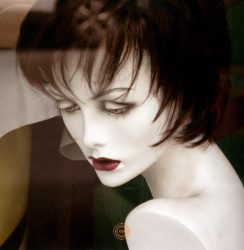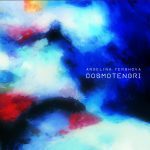ANGELINA YERSHOVA – COSMOTENGRI 
CosmoTengri is Angelina Yershova‘s fourth album on her own Twin Paradox label. The impending atmosphere of the opening track and its video (created by Saltanat Tashimova, who, like Angelina, also comes from Kazakhstan) tells us the album deals with serious issues: ‘the protection of nature and of our planet’s ecosystem, the global issues related to deforestation and sustainability.’
The video is dedicated to “Kok-Zhailau”, a mountain plateau currently at risk of deforestation.
But not all of the album is as dark and gloomy as the opening track. Yershova explores many (sometimes conflicting) emotions, depicted in tracks that range from abstract soundscapes to haunting Shamanic techno rhythms.
The detailed production includes many references to her own cultural background – in sound as well as in symbolism. ‘Kobyzist’ Gulzhan Amanzol, for example, plays the kazakh instrument kyl kobyz on some of the tracks.
Despite the many cultural references, I would not classify this album as ‘world’ music (whatever that may be), because that would pinpoint it to a limited genre, and ignore its cosmopolitan blend of authentic roots, experimental electronics (check the title track to hear what I mean) and cross-cultural rhythms.
With this album, Angelina Yershova ‘proposes a radical change of inner awareness starting from the Earth towards the union with the Cosmos, meant as the universal spirit that we can feel in the last track on the album’.
Her arguments are overwhelming, to say the least.
KERU NOT EVER – THE WIND OF ? 
This album confused me on many levels – which usually is a good sign.
The artist name Keru Not Ever (alias for Montreal artist Justin Leduc-Frenette), the strange title, the cover image, and perhaps most of all: the music.
The opening track Tereza obviously refers to the 2017 debut release with the same title, but I don’t know in which way because I don’t know that album myself. The track quietly opens with a choir sample coupled with ‘the presence of a hyperventilating breath‘ but the tension rises to an extreme level near the end.
From there, the album displays extreme electro-acoustic experiments (the kind that that can be useful to dispel unwanted visitors), as well as beautiful mediaeval choir arrangements. And, weirder even: a combination of these extremes in single tracks.
Everything on this album is unusual. At first, I could not find a right moment to listen to it (it was way too intense for my housemates), but then I became intrigued and I found myself listening to it, again and again, trying to find out what was happening here.
Why the strange name?
The Wind of What?
Why the seemingly incompatible musical extremes?
What is the relation of this music to the cover image?
Why the puzzling liner notes?
What is Justin Leduc-Frenette trying to tell us here (and why does he name himself Keru Not Ever)?
‘[…] the album occurs as an exchange of glances and cracked voices, a mirror game between different and precarious vessels leading to a schizophrenic sensorium similar to the banal and dislocated experience of the new digital ennui. These parasitic breaks are presented as being necessary for the creation and the preservation of an event from which its truth could emanate: spring seems obvious now.’
There are many questions, and probably the answers are irrelevant. The main point is that I kept returning to this album trying to unravel its mysteries, which made this album one of the most intriguing that I listened to in a long time.
I assume that from the above you’ve understood that this album is not exactly for the faint of heart – and it definitely cannot be labelled ‘ambient’. But for listeners free from any dogmas this can be quite an exciting trip!





